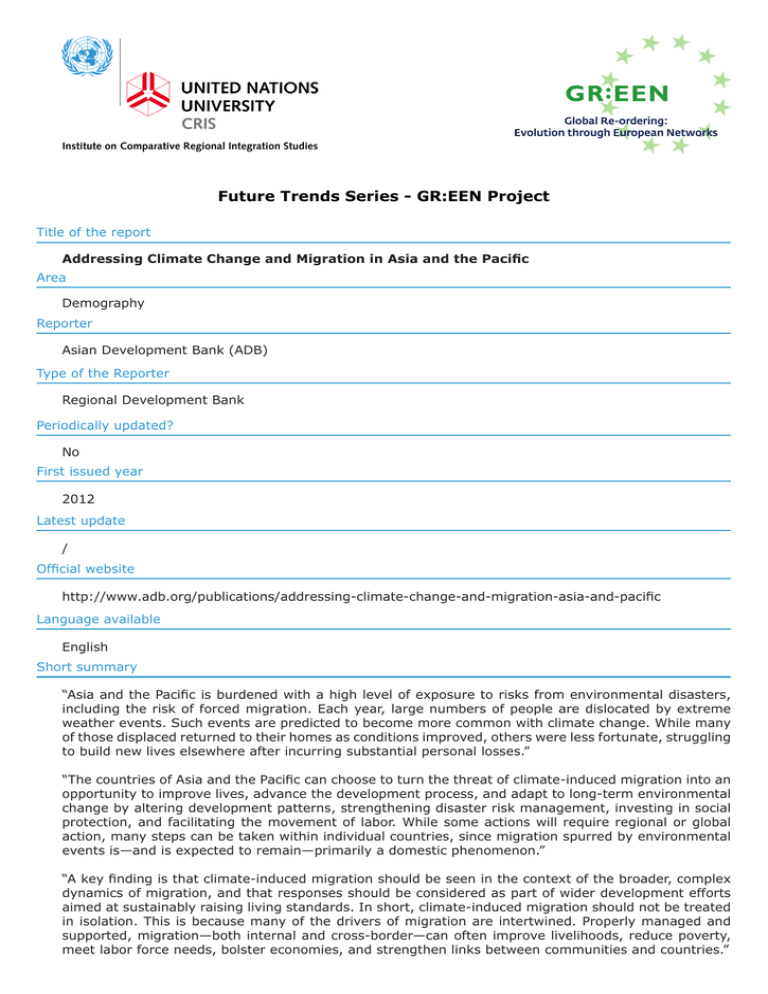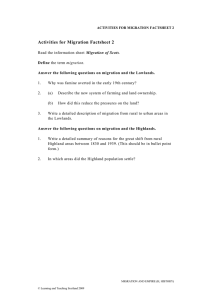Future Trends Series - GR:EEN Project
advertisement

Future Trends Series - GR:EEN Project Title of the report Addressing Climate Change and Migration in Asia and the Pacific Area Demography Reporter Asian Development Bank (ADB) Type of the Reporter Regional Development Bank Periodically updated? No First issued year 2012 Latest update / Official website http://www.adb.org/publications/addressing-climate-change-and-migration-asia-and-pacific Language available English Short summary “Asia and the Pacific is burdened with a high level of exposure to risks from environmental disasters, including the risk of forced migration. Each year, large numbers of people are dislocated by extreme weather events. Such events are predicted to become more common with climate change. While many of those displaced returned to their homes as conditions improved, others were less fortunate, struggling to build new lives elsewhere after incurring substantial personal losses.” “The countries of Asia and the Pacific can choose to turn the threat of climate-induced migration into an opportunity to improve lives, advance the development process, and adapt to long-term environmental change by altering development patterns, strengthening disaster risk management, investing in social protection, and facilitating the movement of labor. While some actions will require regional or global action, many steps can be taken within individual countries, since migration spurred by environmental events is—and is expected to remain—primarily a domestic phenomenon.” “A key finding is that climate-induced migration should be seen in the context of the broader, complex dynamics of migration, and that responses should be considered as part of wider development efforts aimed at sustainably raising living standards. In short, climate-induced migration should not be treated in isolation. This is because many of the drivers of migration are intertwined. Properly managed and supported, migration—both internal and cross-border—can often improve livelihoods, reduce poverty, meet labor force needs, bolster economies, and strengthen links between communities and countries.” Key trends “Though millions of people are already displaced because of environmental disruptions (…), it is likely that this trend will increase substantially in the coming decades, as a result of both climate change and population growth. Addressing this phenomenon today will minimize forced displacement and make the most of migration for development”; “The massive growth in mega cities in coastal areas significantly increases the population exposed to the risks posed by climate change. This is of particular importance where high-risk areas have experienced high levels of damage. Because damage exerts post-disaster employment opportunities, there is the great risk of higher migration rates in cities that are often damaged than in cities that are less affected. People are likely to move to places of high vulnerability, not only away from them”; “Temporary, cyclical, and permanent rural–urban flows are creating strong rural–urban links. Across Asia and the Pacific, such migration is generated by real and perceived inequality of opportunity, and increasing impoverishment in rural areas. In contrast to East and Southeast Asia, urbanization in Central and South Asia is still relatively low, meaning there is still considerable scope for it”; “Similarly, for many populations, large international diasporas establish networks and contacts for future mobility”; “Most rural frontiers that might have settled large numbers of new migrants have already been settled in Asia and the Pacific. People instead are increasingly settling in areas exposed to significant environmental risks such as storm surges, floods, and droughts”; “Conflict has periodically been an important cause of population movement, but movements have been primarily contained within Asia and the Pacific. Where refugee migration has been established, people primarily move along corridors established by original refugee flows”; “Many countries in Asia and the Pacific are highly dependent on remittances”. Suggestions • “Migrants will continue to move to vulnerable areas in Asia and the Pacific, and in particular to cities located in low-lying areas, mostly because of economic opportunities. Urban and peri-urban planning and zoning requirements, together with land allocation and rights, represent major policy challenges in this regard”; • “Though most migration flows associated with environmental events tend to be internal movements, it is important to keep in mind that internal and international migration are typically interlinked. Further, international migration can play a key role in fostering the resilience of households and communities (e.g., through remittances), and can be highly beneficial to both sending and receiving countries. At the same time, the economic, environmental, and social impact of migration on host communities must also be considered”; • “The most vulnerable population groups will often be unable to move in the face of worsening climatic conditions due to a lack of resources or other constraints. Policies addressing climate-induced migration should therefore take into account the needs of communities that are not mobile without some assistance”; • “Overall, climate change is expected to become a key migration driver in Asia and the Pacific, not only because of its direct impacts on migration patterns, but also because of its impacts on different migration drivers, such as poverty, joblessness, and conflict over resources”; • “Many problems connected with climate-induced migration can only be tackled through cooperation between and among sovereign states. Bilateral and multilateral agreements can help to build a regional network of law and standards to manage and facilitate cross-border migration: (i) negotiate bilateral and subregional agreements to enhance freedom of movement (e.g., visafree ASEAN), and extend mutual recognition of academic and skills qualifications; (ii) expand seasonal, short-term, or more permanent labor migration that serves the interests of both source and destination countries, as well as migrant workers (also involves countries outside the region); (iii) step up collaboration among intergovernmental organizations in a position to address climateinduced migration.” Methodology Research from primary sources and secondary sources Reference to other trends reports? If yes, which reports? /






